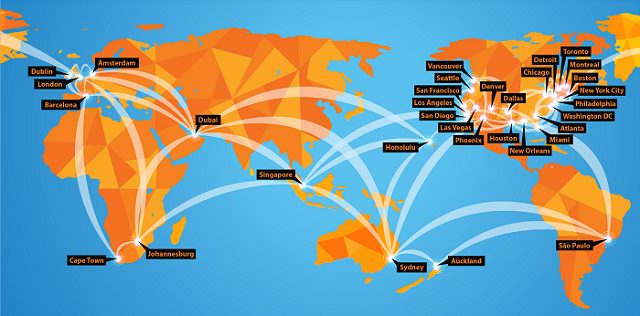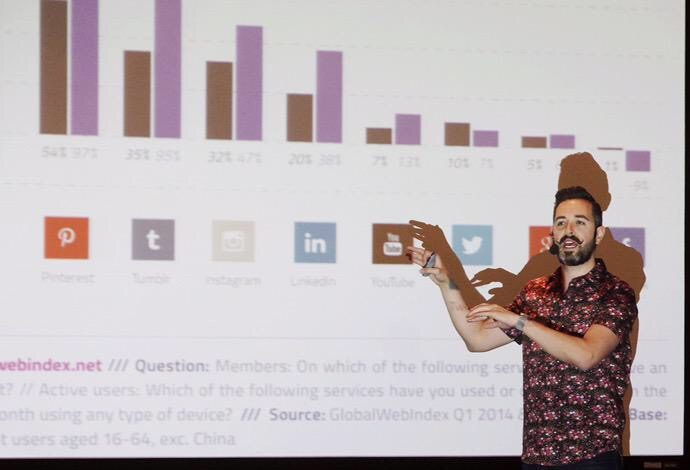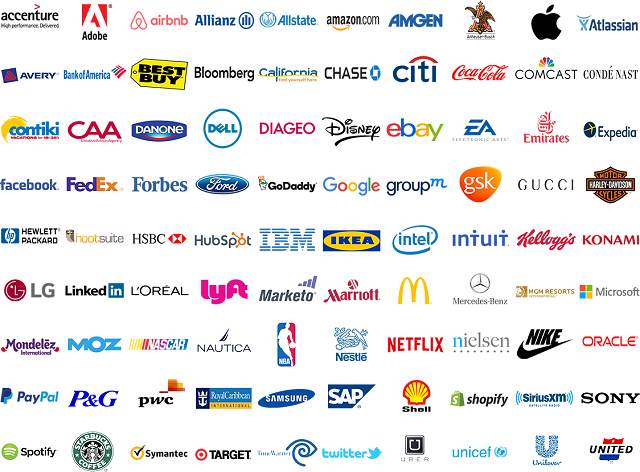Posts Tagged "Digital marketing insights"
Articles
- Best Marketing Conference Sponsorship
- What Does it Mean to Be an Exhibitor at a Conference?
- What Is the Biggest Social Media Conference?
- What Is an Innovation Conference?
- What Is a Typical B2B Event?
- What Are the Cloud Technology Events in 2025?
- Marketing Event Volunteer Opportunities: A Comprehensive Guide
- Digital Marketing Event Volunteer Opportunities Near Me
- What Does a Volunteer Do at a Conference?
- Is DigiMarCon Worth It?
- Is DigiMarCon Good?
- What is the Biggest Marketing Forum?
- What are Digital Marketing Conferences?
- Marketing Conference Exhibiting: Your Guide to Success
- Digital Summit Comparison: A Closer Look at DigiMarCon
- Digital Marketing Conference
- Digital Marketing Events: Your Guide to Success in 2025
- Marketing Conferences: Unlocking Your Business Potential in 2025
- What Is The Future of Digital Marketing in 2030?
- B2B Event Marketing Strategy: Unlocking Success For Your Business
- Why B2B Event Marketing?
- What Should a B2B Marketing Strategy Include?
- Top Marketing Conferences for 2025
- What Is the Future of Marketing in 2025?
Digital Marketing Conferences
- NORTH AMERICA
- DigiMarCon Cruise
(New Orleans, LA, USA) - DigiMarCon West
(Los Angeles, CA, USA) - DigiMarCon Northwest
(Seattle, WA, USA) - DigiMarCon Canada West
(Vancouver, BC, USA) - DigiMarCon Canada
(Toronto, ON, Canada) - DigiMarCon Canada East
(Montreal, QC, Canada) - DigiMarCon Florida
(Orlando, FL, USA) - DigiMarCon Gulf Coast
(Houston, TX, USA) - DigiMarCon Southern California
(San Diego, CA, USA) - DigiMarCon Midwest
(Chicago, IL, USA) - DigiMarCon Mid-South
(Nashville, TN, USA) - DigiMarCon Great Lakes
(Detroit, MI, USA) - DigiMarCon North
(Minneapolis, MN, USA) - DigiMarCon Central
(Kansas City, MO, USA) - DigiMarCon Texas
(Dallas, TX, USA) - DigiMarCon New England
(Boston, MA, USA) - DigiMarCon Mid-Atlantic
(Philadelphia, PA, USA) - DigiMarCon South Florida
(Miami, FL, USA) - DigiMarCon Southeast
(Atlanta, GA, USA) - DigiMarCon Central Florida
(Tampa, FL, USA) - DigiMarCon East
(New York, NY, USA) - DigiMarCon South Atlantic
(Charlotte, NC, USA) - DigiMarCon America
(Washington, D.C. USA) - DigiMarCon Northern California
(San Francisco, CA, USA) - DigiMarCon Rocky Mountains
(Denver, CO, USA) - DigiMarCon South
(San Antonio, TX, USA) - DigiMarCon Silicon Valley
(San Jose, CA, USA) - DigiMarCon Orange County
(Anaheim, CA, USA) - DigiMarCon Southwest
(Phoenix, AZ, USA) - DigiMarCon World
(Las Vegas, NV, USA)
- DigiMarCon Cruise
- LATIN AMERICA
- EUROPE
- MIDDLE EAST
- AFRICA
- ASIA PACIFIC
- DigiMarCon Hawaii & Pacific
(Honolulu, HI, USA) - DigiMarCon Asia & Japan
(Tokyo, Japan) - DigiMarCon New Zealand
(Auckland, New Zealand) - DigiMarCon Australia
(Sydney, Australia) - DigiMarCon Oceania
(Melbourne, Australia) - DigiMarCon Southeast Asia
(Singapore) - DigiMarCon India
(New Delhi, India) - DigiMarCon North Asia & China
(Shanghai, China)
- DigiMarCon Hawaii & Pacific
- VIRTUAL
Digital Marketing Blog
- What Makes DigiMarCon Stand Out (And Is It Worth It?) October 30, 2025
- Is DigiMarCon Worth Attending? A Complete Breakdown October 29, 2025
- DigiMarCon for Startups: Why Founders Shouldn’t Miss It October 29, 2025
- DigiMarCon Recap: What Went Down and What’s Next October 29, 2025

































The Truth About DigiMarCon: Is It Really That Good?
In the realm of digital marketing, staying at the forefront is paramount. The advent of AI and digital marketing has catapulted conferences such as DigiMarCon into the spotlight. These events are now indispensable for professionals aiming to refine their expertise.
Benjamin Kepner’s engagement with DigiMarCon underscores the event’s emphasis on digital marketing and AI. This makes it a pivotal resource for industry insiders.
But is the investment in attending DigiMarCon justified? This article delves into the event’s importance within the digital marketing sphere. It also sheds light on what attendees can anticipate from the gathering.
Curious to uncover more? Obtain the event guide or converse with an advisor to grasp how DigiMarCon can propel your digital marketing endeavors.
Key Takeaways
What Is DigiMarCon and Why It Matters
In the domain of digital marketing conferences, DigiMarCon emerges as a distinguished ‘truth edition’ event. It has garnered significant attention from professionals and businesses, solidifying its position in the industry.
Overview of the DigiMarCon Conference Series
The DigiMarCon conference series assembles experts and innovators within the digital marketing realm. It serves as a platform for the exchange of insights, discussion of current trends, and exploration of novel strategies. Shamla Tech’s engagement in DigiMarCon and other conferences underscores the event’s pivotal role and relevance in the industry.
The conference series encompasses a broad spectrum of topics, ranging from digital marketing strategies to the most recent technological breakthroughs. This all-encompassing approach ensures that attendees acquire a comprehensive understanding of the field and its prospective trajectories.
DigiMarCon’s Position in the Digital Marketing Conference Landscape
DigiMarCon has distinguished itself within the digital marketing conference landscape. Its distinctive amalgamation of industry insights and practical knowledge distinguishes it. The event’s commitment to delivering superior content and facilitating networking opportunities has bolstered its reputation in the industry.
As a DigiMarCon event, it draws a diverse audience, encompassing professionals, businesses, and thought leaders. This diversity enhances the conference experience, offering substantial value to all participants.
The Evolution and History of DigiMarCon
DigiMarCon has undergone profound transformations since its inception, adapting to the dynamic digital marketing landscape. This evolution has ensured the conference’s continued relevance, solidifying its status as a premier industry event.
Origins and Growth Over the Years
DigiMarCon started as a modest gathering focused on emerging digital marketing trends. It has since expanded in size and scope, drawing attendees globally. As Benjamin Kepner noted, the conference has evolved into a pivotal platform for professionals aiming to stay at the forefront of digital marketing.
Changes in Conference Format and Focus
Recently, DigiMarCon has broadened its focus to include cutting-edge topics like AI and machine learning in digital marketing. This shift mirrors the industry’s increasing fascination with these technologies. It also underscores DigiMarCon’s dedication to delivering actionable insights to its audience.
As the digital marketing landscape continues to evolve, DigiMarCon is well-positioned to remain a pivotal player. It offers a platform for industry leaders to disseminate their knowledge and expertise.
Uncovering the DigiMarCon Truth: Quality of Content and Programming
DigiMarCon stands out as a leading digital marketing conference, distinguished by its dedication to delivering superior content and programming. This commitment is reflected in the meticulously selected session topics, crafted to offer attendees actionable insights and seo truth insights.
Analysis of Session Topics and Relevance
The selection of session topics at DigiMarCon is meticulously aligned with the current digital marketing environment. Spanning from the newest social media marketing trends to sophisticated SEO tactics, these topics ensure attendees remain abreast of industry advancements.
For example, sessions on voice search optimization and AI-driven marketing strategies have garnered significant acclaim. These topics directly address critical concerns for marketers, showcasing DigiMarCon’s acumen in meeting industry demands.
Depth vs. Breadth of Content
Conferences face the challenge of balancing in-depth analysis with a broad spectrum of topics. DigiMarCon navigates this by offering a diverse array of sessions, including keynotes, panel discussions, and workshops. This variety caters to both those seeking detailed knowledge in specific areas and those desiring a broader understanding.
The inclusion of sessions tailored for both novices and seasoned professionals ensures the content’s accessibility. This inclusivity positions DigiMarCon as a crucial resource for digital marketing professionals at all levels.
Practical Takeaways and Actionable Insights
DigiMarCon excels in providing practical takeaways and actionable insights. Unlike conferences that focus solely on theoretical knowledge, DigiMarCon emphasizes strategies that can be applied immediately. This hands-on approach is evident in the high engagement levels and overwhelmingly positive feedback from attendees.
By equipping attendees with the tools and knowledge to achieve tangible results, DigiMarCon cements its status as a premier digital marketing conference. The focus on actionable insights ensures that attendees depart with a clear roadmap for implementing their newfound knowledge.
Speaker Lineup and Expertise Evaluation
DigiMarCon distinguishes itself by attracting elite speakers at the vanguard of digital marketing trends. It has solidified its status as a leading event, attracting professionals seeking to learn from the most accomplished. This conference’s reputation is built on its ability to draw in top-tier professionals.
Profile of Typical DigiMarCon Speakers
Speakers at DigiMarCon are seasoned veterans, boasting extensive experience in their domains. They comprise marketing executives, CEOs, and innovators with a history of success. Benjamin Kepner’s post highlights the presence of industry leaders, underscoring the event’s credibility. These experts share their insights, offering the latest in digital marketing strategies.
Industry Leader Representation
DigiMarCon showcases an elite roster of industry leaders, including digital marketing’s most renowned experts. Their presence significantly enhances the conference, providing attendees with insights from industry shapers. Industry insiders emphasize the quality of speakers, highlighting the opportunity to learn from the industry’s elite. This diversity solidifies DigiMarCon’s standing as a premier digimarcon truth seminar.
Speaker Diversity and Fresh Perspectives
The conference takes pride in its speaker diversity, showcasing a variety of perspectives and experiences. This diversity ensures attendees are exposed to a wide range of ideas, from established practices to innovative strategies. The inclusion of fresh voices and perspectives keeps the content engaging, appealing to a broad audience.
In summary, DigiMarCon’s speaker lineup is a cornerstone of its value, offering attendees a unique chance to learn from industry leaders and experts. The diversity and expertise of the speakers significantly enhance the conference’s appeal, making it a must-attend for digital marketing professionals.
Networking Opportunities and Community Building
The essence of DigiMarCon resides in its capacity to unite a myriad of professionals, cultivating a community that excels through collective knowledge and pioneering marketing strategies. This is pivotal for those seeking to broaden their professional networks and acquire wisdom from industry luminaries.
Structured Networking Events and Activities
DigiMarCon presents a spectrum of structured networking events, meticulously crafted to foster genuine connections among participants. These gatherings span from keynote addresses to specialized breakout sessions, all with the objective of promoting collaboration and dialogue.
Quality of Attendees and Potential Connections
The caliber of attendees at DigiMarCon is exceptionally high, featuring a blend of seasoned industry professionals and newcomers. This eclectic mix engenders a fertile ground for potential connections, potentially opening doors to novel business ventures, partnerships, or mentorship roles.
By participating in DigiMarCon, professionals gain not only access to profound insights into the most current truth in marketing strategies but also become integral members of a dynamic community. This community continues to flourish and evolve, extending its influence well beyond the confines of the conference itself.
Value for Money: Ticket Pricing and ROI Analysis
In the realm of authentic digital marketing, assessing the cost-effectiveness of DigiMarCon attendance is paramount. This evaluation necessitates an examination of the various ticket tiers and their corresponding value propositions.
Ticket Options and What They Include
DigiMarCon caters to diverse needs with its array of ticket options. These span from basic passes granting access to keynote sessions to premium packages that include exclusive networking opportunities and one-on-one consultations with industry luminaries.
Premium packages, for example, may encompass access to workshops and masterclasses, offering practical experience with cutting-edge digital marketing tools and methodologies. As Benjamin Kepner’s post elucidates, such immersive experiences can profoundly augment an attendee’s capacity to implement learned strategies efficaciously.
Comparing Cost to Benefit
Assessing DigiMarCon’s ROI mandates a balanced consideration of potential benefits against the financial investment. Attendees can acquire indispensable insights into the latest digital marketing trends and strategies, potentially catalyzing enhanced campaign efficacy and revenue growth.
The essence lies in discerning how the knowledge and connections garnered from the conference can be leveraged to yield concrete outcomes. For many, the opportunity to engage with peers and industry stalwarts is priceless, potentially catalyzing new partnerships or business ventures.
Alternative Ways to Experience DigiMarCon
For those unable to attend DigiMarCon in person, virtual attendance options are available. These enable a wider audience to partake in sessions and networking events, bridging geographical divides.
Further, some conference content may be made available post-event through recordings or written summaries. This provision ensures that those who missed the live event can still derive value from the insights shared.
Real Attendee Experiences and Testimonials
DigiMarCon, a truth-focused conference, has garnered attention for its impactful sessions and networking opportunities. Attendee testimonials reflect the conference’s role as a platform for professionals to share their experiences, challenges, and successes in the digital marketing landscape.
Success Stories from Past Participants
Many attendees have reported significant benefits from participating in DigiMarCon. Shamla Tech, a company that participated, highlighted the conference’s value in providing actionable insights and practical takeaways. They noted the diversity of speakers and the quality of content, appreciating the fresh perspectives and innovative ideas offered.
— Shamla Tech Representative
Other attendees have praised the conference for its structured networking events. These events facilitated meaningful connections and collaborations. The ability to engage with industry experts and peers in a focused environment has been a recurring theme in the feedback.
Common Criticisms and Limitations
While the overall feedback has been positive, some attendees have noted areas for improvement. A few participants felt that certain sessions could have delved deeper into specific topics, suggesting a desire for more specialized content. Others mentioned that the conference could benefit from more diverse representation in terms of speaker demographics.
Despite these criticisms, the consensus among attendees is that DigiMarCon offers substantial value through its programming and networking opportunities. By addressing these limitations, the conference can further enhance the attendee experience and continue to be a leading event in the digital marketing calendar.
Who Benefits Most from Attending DigiMarCon
DigiMarCon stands out as a pivotal event for digital marketing professionals, offering a comprehensive array of topics. It provides a unique platform for gaining insights, fostering networking, and acquiring practical knowledge. This knowledge is directly applicable to various roles within the industry.
Benjamin Kepner’s post underscores the conference’s strength in attracting a diverse range of attendees. This diversity enriches the learning environment, creating a space for exchange and growth.
Ideal Attendee Profiles by Role and Experience Level
DigiMarCon is a treasure trove for digital marketing professionals aiming to stay abreast of the latest trends and strategies. It caters to a wide range of roles, including SEO specialists, social media managers, and content marketers. Sessions are tailored to accommodate both novices and seasoned practitioners, offering foundational knowledge and nuanced insights.
Industries That Gain the Most Value
Certain industries find DigiMarCon’s content exceptionally valuable. E-commerce businesses and agencies offering digital marketing services are among the primary beneficiaries. These sectors can glean actionable insights to enhance their online presence, customer engagement, and digital marketing efficacy.
By participating in DigiMarCon, professionals from these industries can deepen their understanding of the digital realm. They can also expand their professional networks and acquire practical strategies to integrate into their work.
Conclusion: Is DigiMarCon Worth Your Time and Investment?
The DigiMarCon truth unveils a conference that has undergone substantial transformation, emerging as a pivotal platform for digital marketing experts. Its rich speaker roster, meticulously designed networking sessions, and wealth of content solidify its status as a cornerstone event within the industry.
Shamla Tech’s engagement in DigiMarCon and other conferences underscores the event’s importance and the myriad benefits it affords attendees. By participating in DigiMarCon, professionals can acquire practical knowledge, broaden their professional network, and remain abreast of the digital marketing sector’s cutting-edge developments.
Ultimately, the worth of DigiMarCon hinges on your individual objectives and requirements. For those seeking a comprehensive digital marketing landscape overview, DigiMarCon stands out as a prime choice. To maximize your experience, consider requesting the official event guide or consulting with an advisor. This will help you understand how DigiMarCon can catalyze your professional advancement.
The Magic Berry of Reputation: Why I Love DigiMarCon and How Trust Wins in AI Search
In 2025 alone, I’ve spoken at countless DigiMarCon events. At many of them, I’ve run a simple experiment: I hand out lemons and a small red fruit called a Magic Berry. On its own, the lemon is sour. But after eating the berry, that same lemon tastes sweet.
That’s exactly what reputation does. It changes how people perceive you—how they interpret the same “lemon” of your work or your past. Instead of chasing clients or trying to impress strangers, a strong reputation makes people come to you.
After every talk, I stay until the last question is answered. That’s when the best moments happen—when people bring real challenges and get actionable answers. DigiMarCon attracts marketers who care about building long-term reputation over chasing quick wins.
And what I’ve learned from those conversations is simple: people—and search engines—are both looking for signs they can trust you. That matters more than flashy marketing, especially as AI summaries replace traditional search.
Why I Keep Saying Yes to DigiMarCon
I keep saying yes to DigiMarCon because they attract the kind of people who show up ready to learn and actually apply what they hear. Every event I’ve spoken at this year has been packed with real conversations, smart questions, and people who care about doing the work.
It’s rare to find an event series that stays focused on substance across so many locations. That’s why I keep coming back.
Fundamentals Win, Not Tricks
A lot of marketers are still chasing hacks—relying on virality or one-off hits instead of building consistent systems.
However, the most effective systems are simple and repeatable:
Show them something familiar in a new way—just like the Magic Berry turns a sour lemon sweet, clear results change how people see you.
We use the Content Factory to make this sustainable—so every client success, FAQ, or testimonial becomes an asset that builds trust.
Your Offer Isn’t the First Step
When you push your sales page before people trust you, it doesn’t work.
But when people have already seen proof—real experiences, videos, mentions from clients—your offer becomes more credible.
Think about what people are saying about you. Are you collecting that feedback and using it?
The Magic Berry moment in business is when someone experiences that shift—when they realize the work you’ve done all along was valuable, but now it feels different because trust is in place.
If not, start with this: How to Get Google Reviews
How AI Chooses Who to Show
At DigiMarCon, I did live reviews of attendee websites.
The pattern was clear:
We reviewed Joel Yi’s personal branding site live. His site ranked well because he had a detailed About page, multiple third-party mentions, and a strong Google Business profile. That kind of proof builds credibility—for both humans and algorithms.
Why? Because AI ranks trust. Just like people do:
We teach this in Personal Branding Through Authority—where we show people how to earn credibility over time.
What People Are Actually Doing
At a recent DigiMarCon session in San Diego, one business owner told me:
“I’m going to email my 10 happiest customers this week to get Google reviews. I didn’t realize how simple that could be.”
Another marketer said she was:
“Rewriting our About page to include our founder’s story and photos from our first location.”
These aren’t big moves. But they compound. Visibility follows execution.
Why Marketers Fail to Execute
The tactics are simple. The real challenge is execution.
Sending a review request, posting a short FAQ video, or following up with a happy customer is easy. Doing that every week is what separates good marketers from great ones.
Most people want the sweet outcome without realizing that the ‘berry’ is the consistent, boring stuff—like sending follow-ups, tagging reviews, and repurposing small wins.
At DigiMarCon, I opened our Content Factory SOP in front of the audience—walking through the step-by-step process of how we tag reviews in Google Sheets, assign them via our Task Tracker, and convert them into blog snippets and reels.”
One of our clients turned a single Facebook review into 12 content assets across YouTube, Instagram, and their weekly newsletter.
I showed them exactly how we do it—step-by-step in our SOP, using real tools and client examples.
How to Stand Out—Quietly
You don’t need to be flashy. Consistency and value win attention over time.
You need to:
When people trust you, they’re more likely to buy, share your content, and refer you—even if a competitor charges less.
The Shift That Changes Everything
Reputation is your MagicBerry. It changes how people experience everything you say and do. What might have seemed average or overlooked before suddenly carries weight—because people believe you.
When that shift happens, you don’t need to convince. You don’t need to chase. The same content, the same service, the same story hits differently.
That’s the moment people start calling you instead of the other way around.
Want more visibility? Focus on proof. Build habits that earn trust. Do that long enough, and even the sour stuff starts tasting sweet.
Predictive Analytics & Attribution: Insights for Success
In today’s world, knowing how customers behave is key to success. Predictive analytics and attribution help businesses understand their marketing better. This way, they can make smart choices and grow.
Marketers can now analyze complex data and see how their efforts pay off. This changes the game by helping them improve their plans. They can use their resources better and reach their goals.
Key Takeaways
The Data Revolution in Marketing
Data is changing marketing in big ways. Marketers now have lots of data to help them make smart choices. This move to data-driven marketing is changing how businesses talk to customers and plan their strategies.
Marketing data analysis is key in this change. It helps marketers know what customers want, see how well campaigns do, and find new chances. With the right tools, businesses can really get to know their audience and make their marketing better.
The data revolution has many benefits for marketing. It leads to better targeting, happier customers, and easier ways to measure success. As marketers use data more, they can grow their businesses and keep up with the fast-changing market.
What is Predictive Analytics & Attribution?
Marketers need to understand predictive analytics and attribution to boost their campaigns and ROI. Predictive analytics uses past data, models, and algorithms to guess what customers will do next. Attribution is about figuring out which marketing steps led to a customer’s action.
Predictive modeling is a big part of predictive analytics. It helps marketers guess when customers will buy or leave. By looking at lots of data, models find patterns and predict what will happen next. This lets marketers make smart choices.
When predictive analytics and attribution work together, marketing gets better. Businesses can guess what customers will do and see which marketing works best. This way, they can make their campaigns better and use their resources wisely.
Using predictive modeling helps marketers stay ahead. They can make choices based on data, which grows their business.
The Business Case for Advanced Analytics
Advanced analytics is changing the marketing world. It helps make data-driven decision making possible. Marketers can now improve their campaigns, leading to better ROI and more customer engagement.
The case for advanced analytics is strong. It lets marketers go beyond guessing. They use real data to make their strategies. This way, businesses can spend their marketing money wisely, focusing on the most promising customers.
Using advanced analytics, companies can stand out in the market. They can find new chances, guess what customers will do next, and tailor their marketing. This leads to big wins in marketing, helping businesses grow and make more money.
Essential Attribution Models for Marketers
In the world of digital marketing, attribution models help marketers understand how different efforts lead to sales. They are key to seeing how marketing actions add up to customer conversions.
Linear Attribution gives equal credit to all touchpoints. It’s good for marketers who see every interaction as important. But, it might not show the real impact of each touchpoint.
Linear Attribution
Linear attribution assumes every touchpoint has the same effect. It’s simple but might not capture the full story of the customer’s journey.
Time-Decay Attribution
Time-decay attribution values touchpoints closer to the sale more. It’s great for long sales cycles, where recent interactions matter a lot.
As
, picking the right model is crucial for marketing success.
Position-Based Models
Position-based attribution focuses on the first and last touches. The middle interactions get some credit too. It highlights the start and end of the customer’s journey.
Marketing attribution software is essential for using these models. It helps marketers make better decisions about their campaigns. With the right model, businesses can use their resources wisely.
Machine Learning Algorithms Powering Predictive Marketing
Machine learning algorithms are key to predictive marketing. They help businesses make smart choices based on data. These algorithms look at big datasets to spot patterns and guess what customers might do next.
The top machine learning tools in predictive marketing are decision trees, random forests, and neural networks. Decision trees help sort customer data. Random forests deal with complex data interactions. Neural networks find hidden patterns in big datasets.
Using these machine learning algorithms, companies can really get to know their customers. They can then create marketing plans that hit the mark. This keeps them ahead of rivals and boosts sales.
The role of machine learning in predictive marketing will keep growing. Keeping up with new tech in this area is crucial. It helps businesses stay sharp in a fast-changing market.
Customer Journey Tracking Fundamentals
Understanding customer journey tracking is key for businesses to improve their marketing. It involves watching and analyzing how customers interact with different channels. This gives insights into what customers like and do.
Good customer journey tracking helps find and fix problems in the customer path. It lets businesses make smart choices to better the customer experience and increase sales. With advanced analytics and machine learning, businesses can really get to know their customers.
Customer journey tracking gives a full picture of how customers interact with a brand. It shows how they move through marketing channels like social media, email, and websites.
By using strong customer journey tracking, businesses can make their marketing better. They can make customers happier and grow their sales. As marketing changes, tracking the customer journey will be more important for businesses to stay ahead.
Building Effective Predictive Models
Effective predictive models are key to data-driven marketing. Marketers must first pick the right data. This means finding customer behaviors, transaction data, and outside factors that affect marketing.
Next, they need to choose the right algorithms for their models. Algorithms like regression, decision trees, and neural networks are used based on data complexity and marketing goals. For example, regression helps predict things like customer lifetime value. Classification algorithms help find customer groups.
After picking data and algorithms, validating model performance is crucial. This means testing the model on past data to check its accuracy. Adjustments are made as needed. Cross-validation helps make sure the model works well and isn’t too tied to the training data.
By following these steps and improving their models, marketers can better predict customer actions. This leads to more effective marketing campaigns and business growth through data insights.
As marketers get better at predictive modeling, they’ll handle modern marketing’s complexities better. They’ll reach their strategic goals more easily.
Advanced Data Analytics Applications in Marketing
Advanced data analytics is changing marketing by giving insights that lead to success. It uses predictive analytics to guess what customers will do next. This helps marketers plan better.
One big use of advanced data analytics is customer segmentation. It helps businesses find and target specific groups of customers. This way, they can make marketing that really speaks to each group.
Personalization is another big win for advanced data analytics. It lets businesses tailor experiences based on what customers like. This makes customers more engaged and likely to buy.
Advanced data analytics also helps in optimizing marketing campaigns as they go. Marketers can see how well their campaigns are doing. Then, they can make changes based on what the data shows.
Marketing Attribution Software Landscape
Marketing attribution software is key in today’s data-driven marketing world. It helps shape marketing decisions. The software landscape is wide, meeting different business needs and sizes.
The marketing attribution software market has many solutions. You can find simple tools and complex platforms. Look for features like:
Choosing the right marketing attribution software depends on your business needs. Small businesses might want easy-to-use tools that are affordable. Large companies might need scalable software with advanced features.
The marketing attribution software world is always changing. New players and features pop up often. Marketers need to keep up with these changes to get the most from their investments.
Predicting Customer Behavior for Competitive Advantage
To beat the competition, businesses need to use predictive analytics. This helps them understand what customers want. They can then offer what customers need and grow their business.
Predictive analytics lets companies look at past data and current trends. This way, they can guess customer behavior prediction. This knowledge helps them find new chances, make better marketing plans, and keep customers interested.
Some important ways to guess customer behavior include:
By using these methods, businesses can stay ahead. They get a big
In short, customer behavior prediction is key for businesses wanting to do better than others. With predictive analytics, companies can make smart choices and succeed in the long run.
Overcoming Implementation Challenges
The path to using predictive analytics and attribution is full of obstacles. These can slow down even the best plans. Marketers face many hurdles, like bad data, lack of technical skills, and resistance to change.
Data quality is key for good predictive analytics. Your data must be right, complete, and on point. This means doing data checks often and having strong data rules. Data cleansing helps fix problems like wrong data, mixed formats, and missing info.
Not having the right technical skills is another big problem. To solve this, offer training to improve your team’s skills. Or, work with outside experts or use cloud-based analytics tools for help.
Addressing Organizational Resistance
Getting people to accept change is hard. But, you can do it with good change management. Explain the good things about predictive analytics and attribution well. Show how it works by getting early wins. Also, make sure everyone involved in the process.
By tackling these issues, marketers can make predictive analytics and attribution work. This leads to better data-driven decision making and stronger marketing data analysis skills.
Conclusion: The Future of Predictive Analytics in Marketing
Marketers face a complex world of customer engagement. Predictive Analytics and Attribution are key to success. They help businesses use data to improve strategies, enhance customer experiences, and boost revenue.
The future looks bright for predictive analytics in marketing. Advances in machine learning and AI will lead to better predictions and more personalized interactions. Keeping up with these advancements is crucial for staying competitive.
Marketers who use predictive analytics and attribution can grow their businesses. They can see better returns on their investments and run more effective campaigns. As the field evolves, predictive analytics will become even more vital for success in a fast-changing market.
FAQ
What is predictive analytics and how does it apply to marketing?
Predictive analytics uses past data and algorithms to guess future events. In marketing, it helps guess what customers might do next. This guides marketing plans.
How does attribution modeling help marketers understand their campaigns?
Attribution modeling shows how campaigns affect customers. It assigns credit to each touchpoint in the customer’s journey. This helps marketers see which efforts bring the most results.
What are some common attribution models used in marketing?
Marketing uses models like linear, time-decay, and position-based attribution. Each model works differently, depending on marketing goals and data.
How can machine learning algorithms be used in predictive marketing?
Machine learning analyzes big data to predict customer actions. It builds models that forecast what customers might do next. This guides marketing strategies.
What is customer journey tracking and why is it important?
Customer journey tracking follows how customers interact with a brand. It’s key because it shows how customers engage with the brand. It helps spot areas for improvement.
How can marketers overcome implementation challenges when adopting predictive analytics and attribution?
Marketers can tackle challenges by having good data and the right tools and people. They must also explain the value of these tools to others.
What is the role of data analysis in predictive analytics and attribution?
Data analysis is crucial for predictive analytics and attribution. It helps marketers find insights and build models that predict customer actions.
How can predictive analytics be used to drive marketing innovation?
Predictive analytics can spark new ideas in marketing. It helps spot opportunities, meet customer needs, and improve marketing strategies. It also makes customer experiences more personal and boosts ROI.
Viral & Buzz Marketing: Strategies to Ignite Your Brand
In today’s digital world, making your brand stand out is tough. Social media is full of noise, making it hard for your message to be seen. That’s where Viral & Buzz Marketing comes in – a way to cut through the noise and get your brand noticed.
Imagine creating content that your audience loves so much they share it with everyone. This is the power of effective online marketing. With the right strategies, you can create a viral content strategy that makes your brand shine and sets you up for success.
As we dive into Viral & Buzz Marketing, we’ll talk about strategies to reach your online marketing goals. We’ll cover creating engaging content and using social media influencers. We’ll explore it all.
Key Takeaways
The Power of Viral & Buzz Marketing in Today’s Digital Landscape
Social media has changed how brands talk to people. Now, viral and buzz marketing are key for success. They help brands use social media trends to spread their message.
Viral and buzz marketing work by creating buzz online. This buzz helps brands get noticed by more people. It also builds a community around the brand.
Traditional vs. Digital Approaches
Traditional and digital marketing for buzz and viral campaigns are different. Old-school methods use things like events and print ads. Digital marketing uses social media and influencers.
Knowing the good points of both old and new ways helps brands make a strong buzz and viral marketing plan. This plan can reach more people and have a bigger impact online.
The Psychology Behind Content That Spreads
Creating content that spreads like wildfire taps into human emotions and reactions. The psychology of viral content is complex. It involves emotional triggers that make users share it widely.
Awe, Surprise, and Humor
Content that makes us feel awe, surprise, or humor is often shared. It gives us an emotional release or a unique experience. For example, humorous content can brighten someone’s day, encouraging them to share it.
Also, content that inspires awe can motivate sharing because of its profound impact. Marketers can use these emotions in buzzworthy campaigns that are both entertaining and memorable.
Some key elements that make content viral include:
Anger and Anxiety as Motivators
Negative emotions like anger and anxiety can also drive content sharing. Content that highlights social injustices or provokes a strong reaction is shared widely. People share it to raise awareness or vent their frustrations. Effectiveviral marketing techniques often involve understanding and leveraging these emotional motivators.
By understanding the psychological triggers behind content sharing, marketers can develop strategies to increase virality. This involves creating engaging content and understanding the emotional and psychological needs of their audience.
Benefits of Viral & Buzz Marketing for Modern Brands
In today’s digital world, Viral & Buzz Marketing brings many benefits to brands. It helps them grow their online presence. One big plus is it can make your brand more known.
Creating content that people love can make your brand more visible online. This means more people can see and interact with your brand.
Using Viral & Buzz Marketing strategies can help brands grow. The goal is to make content that’s not just good but also gets shared. This way, more people learn about your brand.
This makes your online marketing work better. Your brand becomes stronger in the digital world.
Essential Elements of Successful Viral Campaigns
To make a viral campaign work, you need to know the key elements. These elements help spread your content far and wide. By using them, you can boost your chances of going viral.
Simplicity and Accessibility
Content should be easy for many people to understand and share. Avoid using hard-to-understand words or terms. Clear and concise messaging makes your content relatable and simple to grasp.
A simple design also helps your content get shared more. When it’s easy to use and understand, people are more likely to share it. This boosts your content’s chance to go viral.
Visuals are key to making your content memorable and shareable. Using eye-catching visuals or compelling images grabs attention. It makes your content more engaging.
To really make your content viral, aim to leave a strong impression. Use memorable and impactful visuals that connect with your audience. This way, they’ll remember your content long after seeing it.
By focusing on simplicity, accessibility, visual appeal, and memorability, you can craft a viral content strategy. This strategy will drive engagement and encourage sharing.
Digital Word-of-Mouth: Amplifying Your Brand Message
Digital word-of-mouth turns happy customers into brand fans. It uses viral marketing techniques to get people talking. This makes your brand’s message spread far and wide.
It’s not just about good reviews. It’s about building a community that loves your brand. You can do this with rewards for referrals, content that speaks to your audience, and top-notch customer service.
One great way to get people talking is through campaigns that ask for their stories. For example, you could start a social media contest or hashtag challenge. This gets people involved and shows others that your brand is worth talking about.
Also, working with influencers and brand fans can help a lot. They have lots of followers and can share their real experiences with your brand. This reaches more people and makes your marketing look good.
By focusing on digital word-of-mouth and using smart viral marketing, you can make a strong marketing plan. This plan will help you get noticed, get people involved, and bring in more customers.
Proven Viral & Buzz Marketing Techniques
To make a buzzworthy campaign, brands must think differently. They need to use the latest viral marketing techniques. A good viral marketing plan can really help your brand grow and sell more. We’ll look at some top methods used by viral marketing agencies to connect with people.
One great way is to make content that’s fun and teaches something. This makes people more likely to share it. For example, a funny and engaging video can quickly spread. A marketing pro said, “The secret to viral content is to make it so good, people must share it.”
Another method is to use content made by users. By asking customers to share their stories, brands can build a community. This can be done through contests, giveaways, or just asking for their experiences.
By using these methods, you can make your marketing more likely to go viral. Remember, a viral marketing agency aims to leave a lasting mark on your audience.
In short, making buzzworthy campaigns needs creativity, strategy, and knowing your audience well. By using these techniques and teaming up with a top viral marketing agency, you can elevate your brand.
Platform-Specific Strategies for Content Amplification
To boost content, knowing each platform’s special features is key. As social media grows, brands must update their plans to use the newest social media trends.
Each platform has its own way of getting users involved. For example, Instagram and TikTok need eye-catching visuals and fun videos. Twitter, on the other hand, focuses on quick updates and short messages.
Sound and Music Optimization
Sound and music make content more fun, mainly on TikTok and Instagram Reels. Optimizing sound and music means picking tracks that are popular and connect with your audience.
Challenge Creation Framework
Starting challenges is a great way to get people involved and share your content. A good challenge creation framework picks a theme that matters, makes it simple to join, and offers rewards for finishing.
By using these strategies, brands can really improve their content amplification. It’s all about knowing each platform’s unique needs and adjusting your content to fit.
Case Studies: Viral Marketing Success Stories
Looking at viral marketing campaigns can teach brands a lot. By studying both hits and misses, marketers can learn what works best. This helps them use viral marketing techniques more effectively.
Pepsi’s Kendall Jenner commercial is a great example. It was meant to show unity but caused a big stir instead.
Pepsi’s Kendall Jenner Commercial
In 2017, Pepsi aired an ad with Kendall Jenner. It aimed to show unity and peace. But, it was criticized for using social justice images without permission. Pepsi soon took it down.
This shows how crucial it is to know the cultural context and possible effects of a campaign.
EA also faced backlash on Reddit. Their post was seen as out of touch and insensitive. Many users were upset.
EA’s failure teaches a lesson. Brands must be genuine and considerate when talking to online groups.
By examining these cases, marketers can better understand how to make viral marketing campaigns that connect with people.
Good viral marketing mixes creativity, relevance, and knowing your audience well.
Measuring the Impact of Viral & Buzz Marketing
Measuring the success of viral and buzz marketing is key in today’s digital world. Brands need to track how well their online marketing works. They should look at how much engagement and conversions their viral content brings.
Engagement metrics like likes, shares, and comments show how people interact with viral content. By studying these, brands can make their viral content strategy better fit their audience.
Conversions are what viral marketing aims for: getting people to buy, sign up, or take action. Tracking these shows if viral marketing is worth it. This helps brands make better choices for their future campaigns.
Brands should use many ways to measure viral marketing’s success. They should look at brand mentions, how people feel about them, and what customers say. This gives a full picture of their online image.
With these insights, brands can improve their viral content strategy. They can get more people involved, increase sales, and reach their online goals.
Implementing a Viral Marketing Strategy for Your Brand
In today’s digital world, a viral strategy can unlock your brand’s full potential. To make a campaign go viral, you need to know the key elements.
Brainstorming Viral Concepts
Brainstorming is key in creating a viral marketing campaign. It means thinking creatively and coming up with new ideas that grab people’s attention. Some good ways to do this include:
Working with a viral marketing agency can help a lot. They bring their expertise and creative ideas to your project.
After you have an idea, making sure the production quality is high is important. This means:
By following these tips and teaming up with a trusted agency, you can make buzzworthy campaigns. These campaigns will grab your audience’s attention and boost your brand.
Conclusion: Igniting Your Brand Through Strategic Viral Marketing
Viral & Buzz Marketing is a strong tool for brands today. It helps them leave a mark in the digital world. By using viral marketing, companies can get people talking about their products or services.
Good viral marketing means knowing what makes content spread. It’s about telling stories that grab people’s attention. And using the right platforms to share your message. This way, brands can reach more people and meet their marketing goals.
To make your brand go viral, create content that stands out. It should be interesting and connect with your audience. Mix creativity with data to make a viral marketing plan that works for your business.
FAQ
What is Viral & Buzz Marketing?
Viral & Buzz Marketing uses strategies to spread content fast online. It aims to create buzz and boost brand awareness.
How does Viral Marketing differ from traditional marketing approaches?
Viral Marketing uses digital platforms and social media. It’s about creating digital word-of-mouth. Traditional marketing uses print and TV ads.
What are the key elements of a successful viral campaign?
Good viral campaigns are simple, easy to access, and visually striking. They must be memorable, making it easy for people to share.
How can I measure the impact of my viral marketing efforts?
Track shares, likes, and comments to see how viral your marketing is. Also, look at conversions and other important metrics.
What role does psychology play in creating viral content?
Psychology is key in making content go viral. Emotions like awe, surprise, and humor push people to share.
How can I create a viral marketing strategy for my brand?
Start by brainstorming ideas for viral content. Focus on making it great and consider teaming up with a viral marketing agency.
What are some effective viral marketing techniques?
Good techniques include using social media trends and creating challenges. Also, focus on sound and music, and encourage users to create content.
Can you provide examples of successful viral marketing campaigns?
Pepsi’s Kendall Jenner ad is a great example. It shows how viral marketing can make a brand stand out.
Web Analytics: Uncover Data-Driven Strategies for Growth
In today’s digital world, knowing your online presence is key to success. Data-driven strategies can boost your marketing, leading to better customer interaction and more sales.
Using digital marketing metrics, you can learn a lot about your website. You’ll find out what’s working well and what needs work.
As you face the online world’s challenges, Web Analytics is crucial. It helps guide your decisions, grows your business, and increases your return on investment.
Key Takeaways
The Power of Data-Driven Decision Making
Data-driven decision making turns raw data into useful insights. It helps businesses move away from guessing and towards strategies backed by facts. This is made possible through website data analysis.
User behavior tracking is key in this process. It lets companies see how people use their website. This info helps spot areas to get better and make the site more user-friendly.
Many businesses have found success thanks to data-driven decisions. For example, analyzing how users behave helps shape marketing plans. This makes campaigns more effective and boosts business results.
Choosing a data-driven path helps businesses grow and stay ahead. As the digital world keeps changing, the role of data-driven decisions will grow too.
Understanding Web Analytics Fundamentals
Web analytics is key for any business wanting to grow with data. It’s about collecting, analyzing, and sharing data on how people use websites. This helps companies know their audience, track their online success, and make smart choices for their digital plans.
Web analytics tools gather lots of data, like how many times a page is viewed and how long people stay. These numbers show how users act, helping businesses spot what to improve and where to grow. By looking at this data, companies can make their marketing better, improve user experience, and get more sales.
SEO analytics plays a big part in web analytics. It looks at how search engines see a website, like keyword rankings and organic traffic. By using SEO analytics, businesses can make their site more visible in search results. This brings in more visitors and boosts their online presence.
In short, knowing web analytics is vital for businesses to succeed online. By using web and SEO analytics, companies can understand their audience better, improve their digital plans, and grow steadily.
Essential Web Analytics Metrics for Business Growth
Web analytics metrics are key to shaping business strategies. They offer insights into website performance metrics and conversion rates. This knowledge helps businesses grow and improve their online presence.
Conversion tracking is a vital part of web analytics. It tracks actions on a website, like filling out forms or making purchases. This helps businesses spot areas for improvement and boost their site’s performance.
Important website performance metrics include page load time, bounce rate, and average session duration. These metrics show how users interact with a site. A high bounce rate might mean the site’s content isn’t right for its audience or the user experience is bad.
Conversion tracking is also key for marketing success. It shows which marketing channels work best. This way, businesses can focus their efforts on the most effective channels, ensuring a good return on investment.
Regularly reviewing website performance metrics and conversion tracking data is crucial. This helps businesses spot trends, fix problems, and seize new opportunities. It’s a continuous process that drives growth.
By focusing on the right web analytics metrics and using conversion tracking tools, businesses can improve their online strategies. This leads to better user experiences and more conversions and revenue.
Popular Web Analytics Tools and Platforms
Finding the right web analytics tool is crucial. It can make all the difference between gaining valuable insights and missing out. Businesses need to pick a tool that fits their goals and offers useful data.
Adobe Analytics is a top choice for deep analysis of customer behavior. It gives real-time data, helping businesses make quick decisions. It also lets you segment data, so you can see how different groups behave.
Adobe Analytics
Adobe Analytics is known for its detailed analytics. It includes predictive analytics and customer journey mapping. These features help businesses predict what customers want and plan their strategies.
Matomo and Open-Source Alternatives
Matomo is a great open-source option for those not wanting to use a paid tool. It gives you control over your data and ensures privacy. It offers detailed insights into user behavior, just like Google Analytics, but you own the data.
When picking a web analytics tool, think about data privacy, how easy it is to use, and if it works with other marketing tools. Whether it’s Adobe Analytics, Matomo, or something else, the goal is to find a tool that gives you valuable insights and helps your business grow.
The right web analytics tool depends on what your business needs. By knowing what each tool offers, you can make a choice that boosts your online success.
Implementing Web Analytics Strategy on Your Website
A good web analytics strategy is key for making decisions based on data. To begin, you must set up the right analytics tools on your site. This means picking a strong analytics platform that tracks your digital marketing metrics well.
After that, you need to define key performance indicators (KPIs). These KPIs should match your business goals, like more website visitors, more conversions, or better user interaction. By focusing on the right metrics, you can understand how your website is doing.
With your analytics tools set and KPIs in place, you can use the data to shape your marketing plans. This could mean optimizing your content, finding the right audience, or changing your marketing channels. Checking your website data often helps spot areas to get better and see if your strategies are working.
By adding web analytics to your daily work, you can make smarter choices. This leads to ongoing betterment of your online presence.
Uncovering User Behavior Insights Through Analytics
Businesses can learn a lot about user behavior by using web analytics. These tools show how users move around a website. They reveal what users like and what they find hard.
User behavior tracking is key in web analytics. It helps businesses see how users interact with their site. By looking at page views, bounce rates, and how long users stay, companies can spot areas to get better.
SEO analytics is also important. It helps businesses see how users find their site. By looking at search data, companies can find the right keywords. This helps them rank higher in search results.
Web analytics tools can also show user feedback, heatmaps, and click rates. This info helps companies make their online marketing better. It improves how users engage and boosts sales.
By using both user behavior tracking and SEO analytics, businesses get a full picture of their online presence. This helps them make smart choices to grow their business.
Web Analytics for SEO and Content Optimization
To boost search rankings and content impact, knowing Web Analytics is key. Analyzing website performance metrics helps refine SEO and content for better results.
Web Analytics sheds light on user interactions, top pages, and areas for improvement. This info is vital for spotting SEO chances and tailoring content to user needs.
Web Analytics lets you track keyword success and tweak strategies. Knowing which keywords attract the most visitors helps improve content ranking.
Content Optimization Strategies
By using Web Analytics for SEO and content, businesses can grow online, attract more visitors, and increase sales. Keeping up with website performance metrics is crucial for staying ahead in the digital world.
Data-Driven Conversion Rate Optimization
Data-driven decision making is key to boosting conversion rates. By using web analytics, businesses can see big improvements. This leads to more customers and higher sales.
Understanding Conversion Tracking is vital. It helps spot where to improve in the conversion process. Tracking shows how users act on a site, from start to finish. This info helps find and fix problems.
To really boost conversion rates, businesses need to look at digital marketing metrics. Important ones are conversion rates, bounce rates, and how long users stay. These numbers help understand how well a site is doing and where it can get better.
Actionable Tips for Leveraging Web Analytics
By using these tips and making decisions based on data, businesses can see big gains in conversion rates. Keeping up with conversion tracking and digital marketing metrics helps spot trends and new chances to improve.
Key Takeaways:
Privacy, Ethics, and Compliance in Web Analytics
Web analytics gives us valuable insights into how users behave. But, it also raises big ethical and privacy issues. Businesses must collect and analyze user data in a way that respects privacy and follows the law.
The role of user behavior tracking is huge, but it needs a careful balance. Companies must be open about the data they gather and how they use it.
Following rules like the General Data Protection Regulation (GDPR) and the California Consumer Privacy Act (CCPA) is key. Businesses need to keep up with changing privacy laws and adjust their ways.
In short, dealing with web analytics while keeping user privacy and following rules is tough but vital. By being ethical and following the law, companies can earn trust from their users and create a better online space.
Case Studies: Web Analytics Success Stories
Web analytics has a big impact on business success. Real-world examples show how companies use SEO analytics and Google Analytics insights to grow. They improve their online presence and meet their marketing goals.
An e-commerce company saw a big drop in conversions. They used Google Analytics to find the problem. After improving their website, they saw a 25% increase in sales.
A digital marketing agency helped a client boost their search rankings. They used SEO analytics to understand keyword performance and user behavior. This led to a 50% increase in organic traffic.
These stories show how web analytics can help businesses succeed. By using Google Analytics insights, companies can find new ways to grow. They can also make their marketing better and get a better return on investment.
Conclusion: Building a Culture of Analytics for Sustainable Growth
Effective website data analysis is key for businesses wanting to grow. It helps them make smart decisions. By using web analytics tools, companies can understand how users behave and improve their online presence.
To grow sustainably, businesses need to value analytics. They should use data insights in all parts of the company. This includes marketing, sales, product development, and customer service.
By focusing on data, businesses can adapt fast to market changes. They can find new chances and stay ahead. As the digital world keeps changing, the role of website data analysis and tracking will grow even more.
FAQ
What is web analytics, and why is it important for business growth?
Web analytics is about collecting and analyzing website data. It helps businesses understand how users interact with their site. This knowledge is key to making smart decisions online.
How do web analytics tools work, and what role do they play in SEO?
Web analytics tools track website data. They show how users behave and where they come from. This info is vital for SEO, helping businesses improve their site and rank better in search engines.
What are the most critical web analytics metrics for measuring business growth?
Important metrics include website traffic, bounce rate, and conversion rate. They also look at session duration and pages visited. These metrics help understand user engagement and marketing success.
How can businesses use web analytics to inform their marketing strategies?
Analyzing web analytics data helps spot trends and areas for improvement. This info guides marketing efforts, helping refine targeting and ad campaigns. It also shapes content that appeals to the audience.
What are some popular web analytics tools, and how do they differ?
Tools like Google Analytics, Adobe Analytics, and Matomo are popular. Each has its own strengths and weaknesses. Businesses should pick a tool that fits their needs and goals.
How can businesses ensure they’re using web analytics ethically and in compliance with regulations?
Businesses should be open about data collection and ensure user consent. They must follow laws like GDPR. Also, protecting user data is crucial.
What is conversion rate optimization, and how can web analytics inform CRO efforts?
Conversion rate optimization aims to boost desired actions on a website. Web analytics helps by showing user behavior and funnel bottlenecks. This info guides website improvements.
How can businesses leverage web analytics to drive sustainable growth?
By using data to guide decisions, businesses can grow sustainably. Regularly analyzing data and making improvements is key. This approach enhances online presence and performance.